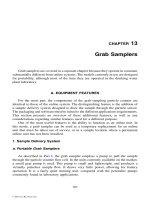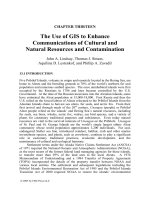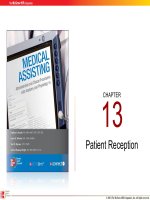Lecture Clinical procedures for medical assisting (4/e): Chapter 13 – Booth, Whicker, Wyman
Bạn đang xem bản rút gọn của tài liệu. Xem và tải ngay bản đầy đủ của tài liệu tại đây (877.65 KB, 46 trang )
CHAPTER
13
Complementary and
Alternative Medicine
© 2011 The McGraw-Hill Companies, Inc. All rights reserved.
132
Learning Outcomes
13.1 Explain CAM.
13.2 Distinguish between complementary and
alternative medicine and conventional
medicine.
13.3 Summarize how CAM and conventional
medicine are used together.
13.4 Identify various types of complementary and
alternative medicine.
© 2011 The McGraw-Hill Companies, Inc. All rights reserved.
133
Learning Outcomes (cont.)
13.5 Describe how a medical assistant may use his
or her knowledge of CAM.
13.6 Explain why patients and health-care
practitioners are turning to complementary
treatments.
13.7 Compare insurance and payment for CAM
treatments.
13.8 Explain how CAM is regulated.
13.9 Describe health fraud.
© 2011 The McGraw-Hill Companies, Inc. All rights reserved.
134
Introduction
• More than 30% of adults use
complementary and alternative therapies
– Relieve problems
– Promote wellness
– No relief from traditional treatments
• Some physicians use a combination of
CAM and traditional therapies
© 2011 The McGraw-Hill Companies, Inc. All rights reserved.
135
What Is CAM?
• A group of practices and products that are
not part of conventional medicine
• Allopathy – conventional medicine or
common and usual practice
• Complementary medicine – used with
conventional medicine
• Alternative medicine – used instead of
conventional medicine
© 2011 The McGraw-Hill Companies, Inc. All rights reserved.
136
What Is CAM? (cont.)
• Scientific evidence concerning safety and
effectiveness
– Available for some CAM therapies
– Research continues, so information changes
• Integrative medicine
– Evolves as CAM therapies are adopted by
conventional medicine
– Combination of both
© 2011 The McGraw-Hill Companies, Inc. All rights reserved.
137
Apply Your Knowledge
Define CAM and state why these therapies are
not in wide use by practitioners of conventional
medicine.
ANSWER: CAM is a group of practices and products not
considered part of conventional medicine. They are not widely
used by physicians because there is not a lot of scientific
evidence of their safety and effectiveness.
© 2011 The McGraw-Hill Companies, Inc. All rights reserved.
138
Types of CAM
• Shared similarities
– Individualized
treatments, good
nutrition, and
preventive health
practices
– Holistic
– Promote self-care and
self-healing
– Recognition of one’s
spiritual nature
• Categories
– Alternative medical
systems
– Mind-body
interventions
– Biologically-based
therapies
– Manipulative and
body-based methods
– Energy therapies
© 2011 The McGraw-Hill Companies, Inc. All rights reserved.
139
Alternative Medical Systems
• Evolved apart from conventional medicine
• Homeopathic medicine
– Treating syndromes and conditions with
remedies that produce similar syndromes and
conditions in healthy people
– Remedy
• Produces the symptoms it is given to treat in order
to stimulate the body’s natural defenses to heal
itself
• Must meet FDA standards
© 2011 The McGraw-Hill Companies, Inc. All rights reserved.
1310
Alternative Medical Systems (cont.)
• Homeopathic medicine
– Looks at individuals, not diseases
• Initial in-depth assessment
• Follow-up – how they are responding
– Medical assistant role
• Similar to other medical offices
• Have knowledge of common remedies
© 2011 The McGraw-Hill Companies, Inc. All rights reserved.
1311
Alternative Medical Systems (cont.)
• Naturopathic medicine
– Relies on the healing power of the body to
establish, maintain, and restore health
– Primary health care
•
•
•
•
Nutritional/lifestyle counseling
Dietary supplements/medicinal plants
Exercise
Homeopathy/traditional Chinese medicine
© 2011 The McGraw-Hill Companies, Inc. All rights reserved.
1312
Alternative Medical Systems (cont.)
• Naturopathic medicine
– Medical assistant – understanding of
treatments
– Traditional Chinese medicine
• Balanced qi (vital energy)
• Flow of qi along meridians (energetic pathways)
• Acupuncture – insertion of hollow needles along
meridians
– Ayurveda – provides guidance regarding food
and lifestyle; India
© 2011 The McGraw-Hill Companies, Inc. All rights reserved.
1313
Mind-Body Interventions
• Enhance the mind’s capacity to affect
bodily function and symptoms
• Support groups and cognitive-behavioral
therapy now part of traditional medicine
• Scientific support
– Placebo effect – WW II
– 35% of therapeutic response is due to belief
© 2011 The McGraw-Hill Companies, Inc. All rights reserved.
1314
Mind-Body Interventions (cont.)
• Most commonly used forms
of CAM
• Types
– Prayer
– Yoga
– Meditation
– Hypnosis
– Biofeedback
© 2011 The McGraw-Hill Companies, Inc. All rights reserved.
1315
Biologically Based Therapies
• Use substances found in nature
– Dietary supplements
– Herbal products
– Foods
• Medical assistant
– Keep up-to-date about dietary and herbal
products
– Be able to provide reliable resources for
patients
© 2011 The McGraw-Hill Companies, Inc. All rights reserved.
1316
Biologically Based Therapies (cont.)
• Dietary supplements
– Manufacturers – no evidence of effectiveness
or safety
– No standardization to ensure consistency
and quality
– Types
• Vitamins Recommended daily amount established
by the FDA
• Minerals
• Herbals – no established recommended daily
amount
© 2011 The McGraw-Hill Companies, Inc. All rights reserved.
1317
Biologically Based Therapies (cont.)
• Patient education for using supplements
– Report all supplements as they would
prescription medications
– Take supplement bottles to appointments
• Document patient’s use of
supplements in the
medical record
© 2011 The McGraw-Hill Companies, Inc. All rights reserved.
1318
Manipulative and Body-Based Methods
• Based on the manipulation and/or movement of
one or more parts of the body
• Types
–
–
–
–
–
Massage therapy
Chiropractic manipulation
Reflexology
Alexander technique
Bowen technique
–
–
–
–
–
Craniosacral therapy
Feldenkrais method
Rolfing
Trager bodywork
Tui Na
© 2011 The McGraw-Hill Companies, Inc. All rights reserved.
Manipulative and Body-Based Methods
1319
(cont.)
• Massage
– Pressure, kneading, stroking, vibration,
and tapping to positively affect health
– Effects
• Relaxation
• Counteracts effects
of stress
• Lowers heart rate and
blood pressure
• Reduces pain/relaxes
muscle spasms
• Improves concentration
• Promotes restful sleep
• Helps the mind relax
© 2011 The McGraw-Hill Companies, Inc. All rights reserved.
Manipulative and Body-Based Methods
1320
(cont.)
• Swedish massage
– Stimulates circulation
and lymph flow
– 5 basic strokes
• Seated massage
– Focuses on back and neck
• Neuromuscular
massage
– Releases tension,
relieves pain and
pressure on nerves,
and increases blood
flow
– Trigger point therapy
© 2011 The McGraw-Hill Companies, Inc. All rights reserved.
Manipulative and Body-Based Methods
1321
(cont.)
• Chiropractic
medicine
– Adjustments
• Manual treatments
to re-align the
vertebra and
restore function of
spinal nerves
• Chiropractor
– Performs an exam
and takes a history
– Tests
• X-rays
• Muscle testing
• Analyzes posture
© 2011 The McGraw-Hill Companies, Inc. All rights reserved.
1322
Energy Therapies
• Bioelectromagnetic-based therapies
– Balances the electromagnetic fields of the
body
– No scientific evidence of efficacy
– Magnetic therapy
• Most common type
• Magnets are used to correct disturbances of
electromagnetic fields and restore health
• FDA – no medical value but relatively harmless
• Avoid for patients with pacemaker or defibrillator
© 2011 The McGraw-Hill Companies, Inc. All rights reserved.
1323
Energy Therapies (cont.)
• Biofield therapies
• Manipulate energy field surrounding the
body
• Reiki
• Therapeutic touch
– Based on qi
– Visualization and touch
balance energy flow to
bring healing energy
to organs and glands
– “Laying-on of hands”
– Hands direct human
energies to help or
heal
– No scientific evidence
of efficacy
© 2011 The McGraw-Hill Companies, Inc. All rights reserved.
1324
Apply Your Knowledge
Match to types of CAM:
A Therapeutic touch
___
ANSWER:
A. Energy therapies
C Chiropractic medicine
___
D Dietary supplements
___
B. Mind-body therapies
B Yoga and meditation
___
D. Biologically-based therapies
E TCM
___
D Herbal supplements
___
E. Alternative medical systems
C. Body-based therapies
E Homeopathy/naturopathy
___
A Magnetic therapy
___
B Hypnosis
___
C Massage
___
© 2011 The McGraw-Hill Companies, Inc. All rights reserved.
1325
Patients Seeking CAM Therapy
• Use is increasing
– Less expensive
– Have fewer side
effects
– More accessible
– Increase in spirituality
• Reasons for seeking
CAM therapy
– Failure of traditional
medical interventions
– Treat side effects of
conventional
medicine’s treatments
– Personal growth
– Environmentalism
– Preventive health care
© 2011 The McGraw-Hill Companies, Inc. All rights reserved.









